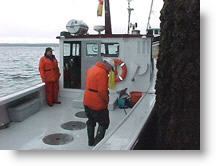|
|
 |
Small Vessel Monitoring & Inspection Program
Small Commercial Vessels
- 0-15 gross tons (0-12 metres)
- including passenger vessels carrying no more than 12 passengers
- other non-pleasure craft
 |
How the Small Vessel Monitoring & Inspection Program Works
The goal of the Small Vessel Monitoring & Inspection Program (SVMIP) is to enhance the safety of small passenger vessels that are not more than 15 gross tons and carry no more than 12 passengers. Commercial fishing vessels are not included in the
SVMIP.
|
| The SVMIP recognizes that owners and operators want to operate safely and Transport Canada’s role is to help them do so. |
Key Parts of the SVMIP
-
Informing owners and operators of requirements;
-
Inspecting each vessel to verify compliance before it enters service;
-
Providing tools for and promoting regular self-inspections;
-
Identifying risk factors for each vessel;
-
Carrying out spot checks of vessels of higher risk and in response to safety concerns, as well as at random.
Here’s how the program works for you
See a flowchart of the SVMIP process.
The law says a vessel must have an inspection and a safety certificate prior to entering service. If you own or operate a small commercial vessel that has not yet been inspected by a Transport Canada Marine Safety Inspector, it's your responsibility to arrange for an inspection. Fill out the
Request for Inspection (301 KB)  form and fax to your nearest Transport Canada Centre.
form and fax to your nearest Transport Canada Centre.
The inspection will verify the vessel and crew meet the safety requirements for:
- Construction of hull and machinery
- Stability
- Lifesaving, navigation communication equipment
- Training and certification of crewmembers
The Steps
- When you request an inspection, a Transport Canada Marine Safety Inspector will send you the
First/Initial Inspection Checklist (374 KB)
 and other information to help you to understand the requirements that apply to your vessel and operation. With the checklist, you can verify your vessel's standards with the compliance requirements prior to the Transport Canada inspection. Identification and rectification of items that don't meet the requirements beforehand will prevent surprises and serve to reduce the time required to inspect. If you have questions about the safety requirements for your vessel
Contact
Us.
and other information to help you to understand the requirements that apply to your vessel and operation. With the checklist, you can verify your vessel's standards with the compliance requirements prior to the Transport Canada inspection. Identification and rectification of items that don't meet the requirements beforehand will prevent surprises and serve to reduce the time required to inspect. If you have questions about the safety requirements for your vessel
Contact
Us.
- When you have completed your review and are satisfied that your crew and vessel meet the requirements, advise the inspector or Transport Canada Centre you previously contacted and an inspection will be scheduled.
- An inspector will visit your vessel and verify it complies with the applicable criteria. There is no charge for the initial/first inspection in most cases. Upon satisfactory completion of the inspection the inspector will issue a Notice of Inspection. The Notice of Inspection, which sets out the vessel’s operating limits, such as voyage limitations and maximum number of passengers, is proof that your vessel has been
inspected. Passenger vessels may be issued a decal
(43.5 KB)
 for display. Decals have areas on them for annual endorsement stickers. To obtain a sticker, inspect your vessel using the
Self-Inspection Checklist
(242 KB) for display. Decals have areas on them for annual endorsement stickers. To obtain a sticker, inspect your vessel using the
Self-Inspection Checklist
(242 KB)  , fill out an Annual Self-Inspection Information Report
(54.5 KB)
, fill out an Annual Self-Inspection Information Report
(54.5 KB)  (ASIIR) and send it to your local Transport Canada
Centre.
(ASIIR) and send it to your local Transport Canada
Centre.
- If an item on your vessel does not meet the requirements on the first visit, the inspector will guide you through how to correct it. Where deficiencies compromise safety, the inspector will insist the vessel not be used for commercial operations until the
deficiencies have been addressed. If the inspector has to make additional visits to verify that all is in order, a fee may be charged - another reason to verify the vessel yourself before requesting an inspection. Further information on inspection services rates can be found
here.
- The Transport Canada Marine Safety Inspector consults and advises of potential problems with your vessel and explains why certain standards are vital to your operation. Your inspector is available throughout the process and will assist you whenever possible.
Self-Inspections
You are responsible for making sure that your operation meets the safety requirements. Giving your vessel a thorough review on a regular basis will help you do this and may identify potential problems early, thereby reducing cost of repair. If you would like to receive an endorsement sticker for the your passenger vessel decal, self-inspection must be carried out at least every year.
Use the Self-Inspection Checklist
(242 KB)  and guidelines
to help you, and then let us know you've done it by filling out and sending the Annual Self-Inspection Information Report
(54.5 KB)
and guidelines
to help you, and then let us know you've done it by filling out and sending the Annual Self-Inspection Information Report
(54.5 KB)  to your local Transport
Canada Centre.
to your local Transport
Canada Centre.
Spot Checks
Spot checks will be performed to verify that vessels continue to comply with safety requirements. During a spot check the inspector may ask to see crewing certification, lifesaving equipment and other items. The checks are always unscheduled with vessels selected at random, according to risk factors or in response to a complaint. There is no fee associated with a spot check, however, if the vessel is noncompliant and a return visit is required, a fee will be charged.
|

